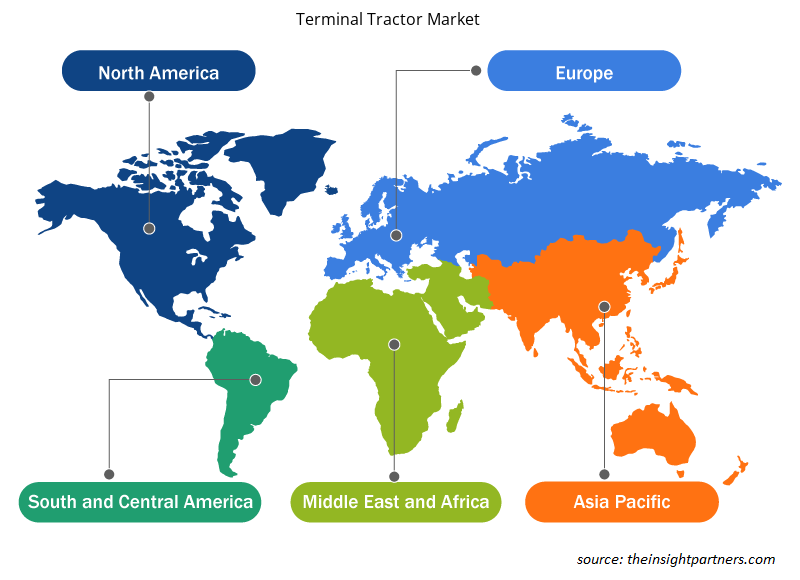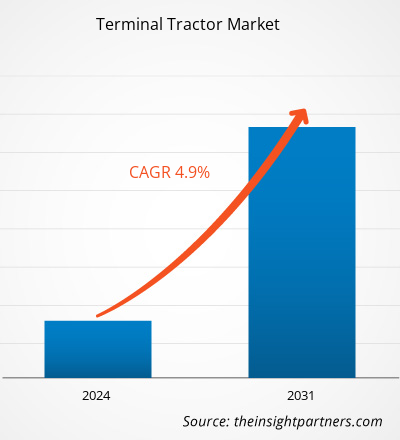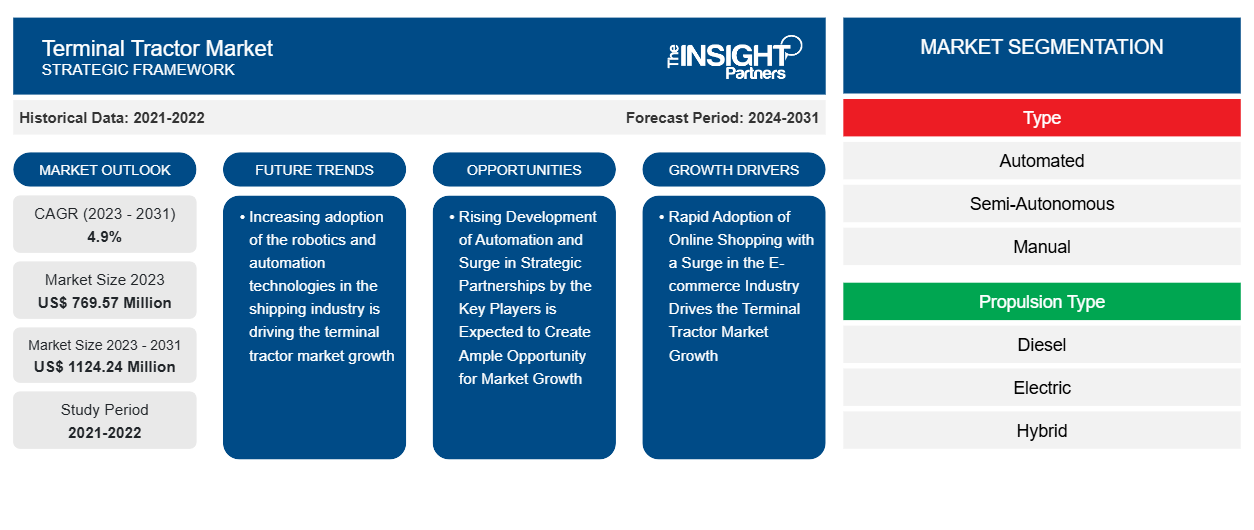Der Markt für Terminaltraktoren soll von 769,57 Millionen US-Dollar im Jahr 2023 auf 1.124,24 Millionen US-Dollar im Jahr 2031 anwachsen. Der Markt soll in den Jahren 2023–2031 eine durchschnittliche jährliche Wachstumsrate (CAGR) von 4,9 % verzeichnen. Der Markt für Terminaltraktoren wird durch die steigende Nachfrage der E-Commerce-Branche nach Versandgütern angetrieben. Auch der Anstieg der Nachfrage nach Lösungen für den Frachtumschlag in Schiffen, Terminals, Häfen und lokalen Vertriebszentren ist ein wichtiger Wachstumsfaktor für den Markt für Terminaltraktoren. Diese Traktoren bieten eine hohe Zuverlässigkeit und höhere Transportkapazität und können sperrige Güter effizient transportieren. Laut der Konferenz der Vereinten Nationen für Handel und Entwicklung (UNCTAD) wurden im Jahr 2021 in Häfen weltweit mehr als 849,5 Millionen 20-Fuß-Container bewegt.CAGR of 4.9% in 2023–2031. The market for terminal tractors is driven by the increasing e-commerce industry's rising demand for shipping goods. Also, the surge in the demand for cargo-handling solutions in the ships, terminals, ports, and local distribution centers is a major driving factor for the terminal tractor market growth. These tractors provide high reliability and higher shipping capacity and are capable of transporting bulky goods efficiently. According to the United Nations Conference on Trade and Development (UNCTAD), more than 849.5 million twenty-foot equivalent moved containers at ports worldwide in 2021.
Marktanalyse für Terminaltraktoren
Hersteller von Terminaltraktoren konzentrieren sich auf die Entwicklung neuer Produkte und die Markteinführung mehrerer Produkte, um auf dem globalen Markt für Terminaltraktoren wettbewerbsfähig zu bleiben. Hersteller von Terminaltraktoren legen Wert auf die Einführung fortschrittlicher Funktionen und Funktionalitäten in ihren Produkten, um deren Anwendungsbereich zu erweitern. Zunehmende Fusionen, Partnerschaften, Kooperationen und Übernahmen, die den Herstellern von Terminaltraktoren helfen, ihre Marktpräsenz weltweit auszubauen, schaffen reichlich Gelegenheit für Marktwachstum. Unternehmen für Terminaltraktoren bieten Partnerschaften mit Logistik- und Lagerbetreibern, Reedereien und Handelsunternehmen an, um Transportmöglichkeiten zu sichern und so den Umsatz langfristig zu steigern.
Marktübersicht für Terminaltraktoren
Die Logistikdienstleister auf der ganzen Welt nutzen Terminalzugmaschinen in großem Umfang. Der wachsende Logistiksektor mit dem rasanten Aufkommen der E-Commerce-Branche ist ein wichtiger Wachstumsfaktor für den Markt für Terminalzugmaschinen im Prognosezeitraum. Terminalzugmaschinen sind Industriefahrzeuge der Klasse 8, mit denen Sattelanhänger sowie beladene und leere Versandcontainer effizient und schnell über kurze Distanzen transportiert werden können. Sie werden häufig in Lagerhallen, Verschiffungshäfen, Fracht- und LKW-Terminals sowie Cross-Dock-Einrichtungen eingesetzt und sind sowohl für den Einsatz im Gelände als auch auf der Straße ausgelegt. Sie sind unter verschiedenen Namen bekannt, wie z. B. Yard Truck, Yard Jockey, Spotter Truck, Yard Hosteler und Shunt Truck. Zu ihren Merkmalen gehören eine versetzte Einzelkabine mit verbesserter Sicht des Fahrers, ein kurzer Radstand für den Wenderadius und Schiebetüren für den Fahrer.
Passen Sie diesen Bericht Ihren Anforderungen an
Sie erhalten kostenlose Anpassungen an jedem Bericht, einschließlich Teilen dieses Berichts oder einer Analyse auf Länderebene, eines Excel-Datenpakets sowie tolle Angebote und Rabatte für Start-ups und Universitäten.
-
Holen Sie sich die wichtigsten Markttrends aus diesem Bericht.Dieses KOSTENLOSE Beispiel umfasst eine Datenanalyse von Markttrends bis hin zu Schätzungen und Prognosen.
Treiber und Chancen auf dem Terminaltraktormarkt
Schnelle Verbreitung des Online-Shoppings mit einem Aufschwung in der E-Commerce-Branche treibt das Wachstum des Terminaltraktormarktes an
Die rasant wachsende E-Commerce-Branche hat eine enorme Nachfrage nach globalen Terminaltraktoren zur Verwaltung von Paketlieferungen und Endverbrauchern geschaffen. Die steigende Nachfrage nach Online-Shopping sowie das schnelle Wachstum der Internetdurchdringung weltweit sind ein wichtiger Antriebsfaktor für das Wachstum des Terminaltraktormarktes. Die Umsätze im E-Commerce-Sektor in den USA, die im Jahr 2023 auf 1,12 Billionen US-Dollar geschätzt wurden, stiegen um rund 7,6 % gegenüber 1,03 Billionen US-Dollar im Jahr 2022. Gleichzeitig beliefen sich die weltweiten E-Commerce-Umsätze im Jahr 2023 auf 5,08 Billionen US-Dollar, was einem Anstieg von 3,8 % gegenüber 2022 entspricht. Diese schnelle Akzeptanz des Online-Shoppings mit dem Anstieg des E-Commerce-Sektors auf der ganzen Welt treibt das Wachstum des Terminaltraktormarktes im Prognosezeitraum voran.
Mit der rasanten Expansion der E-Commerce-Branche stieg auch die Nachfrage nach Terminaltraktoren für den Paket- und Warentransport. Die wichtigsten Sektoren, die das Wachstum des Terminaltraktormarktes vorantreiben, sind Schifffahrt, Pharmazeutika, Einzelhandel, Lebensmittel und Getränke. Darüber hinaus wird das Wachstum des Terminaltraktormarktes durch den Anstieg der schnelldrehenden Konsumgüter vorangetrieben, der das Wachstum des Terminaltraktormarktes im Prognosezeitraum vorantreibt.
Die zunehmende Entwicklung der Automatisierung und der Anstieg strategischer Partnerschaften durch die wichtigsten Akteure dürften reichlich Gelegenheit für Marktwachstum schaffen
Die wichtigsten Akteure auf dem Markt für Terminaltraktoren gehen strategische Partnerschaften ein, um die Nachfrage der Verbraucher zu befriedigen. So ging Kalmar, die Geschäftsabteilung von Cargotec, im August 2022 eine Partnerschaft mit Maldives Ports Ltd. ein, um T2i drei Terminaltraktoren anzubieten. Der Kauf erfolgte aus dem Bestand von Cargotec und die Lieferung erfolgte im ersten Quartal 2023.
- Im Juli 2022 ging Kalmar eine Partnerschaft mit Helsingborg Ports Ltd. ein, um das Kalmar Electric Traktorterminal Reachstacker anzubieten. Die Vereinbarung umfasst Schulungen zur Einführung des Traktorterminals, zu Gerätebedienern und zu Wartungsanforderungen.
- Im Juni 2022 brachte Terberg vollautomatische Elektrotraktoren auf den Markt. Es handelt sich um ein autonomes Design, das für den gemischten Verkehr konzipiert ist. Es handelt sich um einen effizienten und sicheren autonomen Transport.
- Im Januar 2022 ging Kalmar eine Partnerschaft mit Coast Autonomous Inc. ein, um das fortschrittliche Roboterportfolio von Kalmar auf den Markt zu bringen. Die Produkte bestehen aus intelligenten mobilen Ausrüstungslösungen, die die Produktivität des Gütertransports und der Materialhandhabung steigern sollen.
Segmentierungsanalyse des Marktberichts für Terminaltraktoren
Wichtige Segmente, die zur Ableitung der Marktanalyse für Terminaltraktoren beigetragen haben, sind Typ, Plattform, Anwendung und Endbenutzer.
- Je nach Typ ist der Markt in automatisierte, halbautonome und manuelle unterteilt. Unter diesen hat das Handbuch im Jahr 2023 den größten Anteil, und dies ist auf die rasant gestiegene Nachfrage im gesamten Logistik- und Vertriebssektor zurückzuführen.
- Je nach Antriebsart wird der Markt in Diesel , Elektro, Hybrid und CNG unterteilt. CNG verzeichnet hier aufgrund der höheren Effizienz und der gestiegenen Nachfrage im Logistiksektor ein rasantes Wachstum.
- Basierend auf der Anwendung ist der Markt für Terminaltraktoren in Materialhandhabung, Logistik und Vertrieb, Flughäfen, Containerterminals und andere unterteilt. Unter diesen Sektoren hat der Logistik- und Vertriebssektor im Jahr 2023 den größten Anteil.
Marktanteilsanalyse für Terminaltraktoren nach Geografie
Der geografische Umfang des Berichts zum Markt für Terminaltraktoren ist hauptsächlich in fünf Regionen unterteilt: Nordamerika, Europa, Asien-Pazifik, Naher Osten und Afrika sowie Südamerika.
Nordamerika wird voraussichtlich im Jahr 2023 den größten Anteil haben, und die USA wachsen im Prognosezeitraum rasant. Dieses Wachstum ist auf die Präsenz großer Hersteller wie Kalmar, Inc., REV Group Inc., Terberg und Mol zurückzuführen. Darüber hinaus treiben steigende Investitionen und die zunehmende Einführung neuester Technologien im Logistik- und Lagersektor dieser Region das Wachstum des Marktes für Terminaltraktoren voran.
Der asiatisch-pazifische Raum verzeichnet im Prognosezeitraum aufgrund der zunehmenden Dominanz chinesischer Akteure beim Containertransport in China das höchste CAGR-Wachstum. Auch der wachsende E-Commerce-Sektor, die Entstehung der Globalisierung, die Entwicklung von Industrie 4.0 und die Einführung intelligenter Fabriken in den Entwicklungsländern im asiatisch-pazifischen Raum treiben das Wachstum des Marktes für Terminaltraktoren im Prognosezeitraum voran.CAGR during the forecast period owing to the rising dominance of Chinese players to ship containers in China. Also, the rising E-commerce sector, the emergence of globalization, industry 4.0 evolution, and the adoption of smart factories across the developing nations in the Asia Pacific region drive the terminal tractor market growth during the forecast period.
Auch Europa verzeichnet im Prognosezeitraum ein beträchtliches Wachstum aufgrund der bestehenden Nachfrage nach Terminaltraktorprodukten in wichtigen Ländern wie Italien, Frankreich, Deutschland und Großbritannien.
Regionale Einblicke in den Terminaltraktormarkt
Die regionalen Trends und Faktoren, die den Markt für Terminaltraktoren im Prognosezeitraum beeinflussen, wurden von den Analysten von Insight Partners ausführlich erläutert. In diesem Abschnitt werden auch die Marktsegmente und die Geografie des Terminaltraktorenmarkts in Nordamerika, Europa, im asiatisch-pazifischen Raum, im Nahen Osten und Afrika sowie in Süd- und Mittelamerika erörtert.

- Erhalten Sie regionale Daten zum Terminaltraktormarkt
Umfang des Marktberichts für Terminaltraktoren
| Berichtsattribut | Details |
|---|---|
| Marktgröße im Jahr 2023 | 769,57 Millionen US-Dollar |
| Marktgröße bis 2031 | 1124,24 Millionen US-Dollar |
| Globale CAGR (2023 - 2031) | 4,9 % |
| Historische Daten | 2021-2022 |
| Prognosezeitraum | 2024–2031 |
| Abgedeckte Segmente |
Nach Typ
|
| Abgedeckte Regionen und Länder |
Nordamerika
|
| Marktführer und wichtige Unternehmensprofile |
|
Marktteilnehmerdichte für Terminaltraktoren: Auswirkungen auf die Geschäftsdynamik verstehen
Der Markt für Terminaltraktoren wächst rasant, angetrieben durch die steigende Nachfrage der Endnutzer aufgrund von Faktoren wie sich entwickelnden Verbraucherpräferenzen, technologischen Fortschritten und einem größeren Bewusstsein für die Vorteile des Produkts. Mit steigender Nachfrage erweitern Unternehmen ihr Angebot, entwickeln Innovationen, um die Bedürfnisse der Verbraucher zu erfüllen, und nutzen neue Trends, was das Marktwachstum weiter ankurbelt.
Die Marktteilnehmerdichte bezieht sich auf die Verteilung von Firmen oder Unternehmen, die in einem bestimmten Markt oder einer bestimmten Branche tätig sind. Sie gibt an, wie viele Wettbewerber (Marktteilnehmer) in einem bestimmten Marktraum im Verhältnis zu seiner Größe oder seinem gesamten Marktwert präsent sind.
Die wichtigsten auf dem Markt für Terminalzugmaschinen tätigen Unternehmen sind:
- Kalmar, Inc.
- Konecranes Oyj
- Sany-Gruppe
- Terberg Group BV
- Hyster-Yale Materials Handling, Inc.
- MAFI Transport-Systeme GmbH
Haftungsausschluss : Die oben aufgeführten Unternehmen sind nicht in einer bestimmten Reihenfolge aufgeführt.

- Überblick über die wichtigsten Akteure auf dem Terminaltraktormarkt
Nachrichten und aktuelle Entwicklungen zum Terminaltraktormarkt
Der Markt für Terminaltraktoren wird durch die Erhebung qualitativer und quantitativer Daten nach Primär- und Sekundärforschung bewertet, die wichtige Unternehmensveröffentlichungen, Verbandsdaten und Datenbanken umfasst. Im Folgenden finden Sie eine Liste der Entwicklungen auf dem Markt für Terminaltraktoren und Strategien:
- Im August 2022 erhielt Kalmar, das zu Cargotec gehört, den Liefervertrag für die drei T2i-Terminaltraktoren beim Maldives Port Limited. Die Bestellungen sollen bis zum ersten Quartal 2023 ausgeliefert werden. (Quelle: DJI, Pressemitteilung/Unternehmenswebsite/Newsletter)
- Im Juni 2022 gab das Terminal der Elfenbeinküste die Lieferung von 14 neuen elektrischen Terminaltraktoren des Typs APM 75T HE von Gaussin für den Einsatz im Transportbereich des Hafens von Abidjan bekannt. Die Bestellung umfasste jedoch 36 Terminaltraktoren, die schrittweise bis zum letzten Quartal 2022 geliefert wurden. (Quelle: DJI, Pressemitteilung/Unternehmenswebsite/Newsletter)
Marktbericht zu Terminaltraktoren – Umfang und Ergebnisse
Der Bericht „Marktgröße und Prognose für Terminaltraktoren (2021–2031)“ bietet eine detaillierte Analyse des Marktes, die die folgenden Bereiche abdeckt:
- Marktgröße und Prognose auf globaler, regionaler und Länderebene für alle wichtigen Marktsegmente, die im Rahmen des Projekts abgedeckt sind
- Marktdynamik wie Treiber, Beschränkungen und wichtige Chancen
- Wichtige Zukunftstrends
- Detaillierte PEST-Analyse
- Globale und regionale Marktanalyse mit wichtigen Markttrends, wichtigen Akteuren, Vorschriften und aktuellen Marktentwicklungen
- Branchenlandschaft und Wettbewerbsanalyse, einschließlich Marktkonzentration, Heatmap-Analyse, prominenten Akteuren und aktuellen Entwicklungen
- Detaillierte Firmenprofile mit SWOT-Analyse
- Historische Analyse (2 Jahre), Basisjahr, Prognose (7 Jahre) mit CAGR
- PEST- und SWOT-Analyse
- Marktgröße Wert/Volumen – Global, Regional, Land
- Branchen- und Wettbewerbslandschaft
- Excel-Datensatz
Aktuelle Berichte
Erfahrungsberichte
Grund zum Kauf
- Fundierte Entscheidungsfindung
- Marktdynamik verstehen
- Wettbewerbsanalyse
- Kundeneinblicke
- Marktprognosen
- Risikominimierung
- Strategische Planung
- Investitionsbegründung
- Identifizierung neuer Märkte
- Verbesserung von Marketingstrategien
- Steigerung der Betriebseffizienz
- Anpassung an regulatorische Trends























 Kostenlose Probe anfordern für - Markt für Terminaltraktoren
Kostenlose Probe anfordern für - Markt für Terminaltraktoren